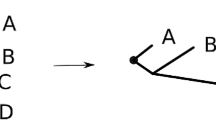Abstract
Accurate estimation of species divergence times from the analysis of genetic sequences relies on probabilistic models of evolution of the rate of molecular evolution. Importantly, while these models describe the sample paths of the substitution rates along a phylogenetic tree, only the (random) average rate can be estimated on each edge. For mathematical convenience, the stochastic nature of these averages is generally ignored. In this article we derive the probabilistic distribution of the average substitution rate assuming a geometric Brownian motion for the sample paths, and we investigate the corresponding error bounds via numerical simulations. In particular we confirm the validity of the gamma approximation proposed in Guindon (Syst Biol 62(1):22–34, 2013) for “small” values of the autocorrelation parameter.








Similar content being viewed by others
References
Albanese C, Lawi S (2005) Laplace transforms for integrals of Markov processes. Markov Process Relat Fields 11(4):677–724
Aris-Brosou S, Yang Z (2002) Effects of models of rate evolution on estimation of divergence dates with special reference to the metazoan 18S ribosomal RNA phylogeny. Syst Biol 51:703–714
Felsenstein J (1981) Evolutionary trees from DNA sequences: a maximum likelihood approach. J Mol Evol 17:368–376
Gernhard T (2008) The conditioned reconstructed process. J Theor Biol 253(4):769–778
Guindon S (2013) From trajectories to averages: an improved description of the heterogeneity of substitution rates along lineages. Syst Biol 62(1):22–34
Ishiyama K (2005) Methods for evaluating density functions of exponential functionals represented as integrals of geometric Brownian motion. Methodol Comput Appl Probab 7(3):271–283
Karlin S, Taylor HM (1981) A second course in stochastic processes. Academic Press Inc., New York
Kingman JFC (1982) The coalescent. Stoch Process Appl 13:235–248
Kishino H, Hasegawa M (1989) Converting distance to time: application to human evolution. Methods Enzymol 183:550–570
Kishino H, Thorne JL, Bruno WJ (2001) Performance of a divergence time estimation method under a probabilistic model of rate evolution. Mol Biol Evol 18(3):352–361
Kumar S (2005) Molecular clocks: four decades of evolution. Nat Rev Genet 6(8):654–662
Lepage T, Lawi S, Tupper P, Bryant D (2006) Continuous and tractable models for the variation of evolutionary rates. Math Biosci 199:216–233
Lepage T, Bryant D, Philippe H, Lartillot N (2007) A general comparison of relaxed molecular clock models. Mol Biol Evol 24:2669–2680
Matsumoto H, Yor M (2005) Exponential functionals of Brownian motion. I. Probability laws at fixed time. Probab Surv 2:312–347 (electronic)
Nee S, May R, Harvey P (1994) The reconstructed evolutionary process. Philos Trans R Soc B 344(1309):305–311
Ohta T, Kimura M (1971) On the constancy of the evolutionary rate of cistrons. J Mol Evol 1(1):18–25
Privault N, Uy WT (2013) Monte Carlo computation of the Laplace transform of exponential Brownian functionals. Methodol Comput Appl Probab 15(3):511–524
Rannala B, Yang Z (2007) Inferring speciation times under an episodic molecular clock. Syst Biol 56:453–466
Sanderson M (1997) A nonparametric approach to estimating divergence times in the absence of rate constancy. Mol Biol Evol 14:1218–1231
Sarich V, Wilson A (1967) Immunological time scale for hominid evolution. Science 158:1200–1203
Thompson EA (1975) Human evolutionary trees. CUP Archive, Cambridge
Thorne J, Kishino H, Painter I (1998) Estimating the rate of evolution of the rate of molecular evolution. Mol Biol Evol 15:1647–1657
Tuffley C, Steel M (1998) Modeling the covarion hypothesis of nucleotide substitution. Math Biosci 147(1):63–91
Watson GN (1995) A treatise on the theory of Bessel functions. Cambridge University Press, Cambridge (reprint of the second (1944) edition)
Yor M (1992) On some exponential functionals of Brownian motion. Adv Appl Probab 24(3):509–531
Zuckerkandl E, Pauling L (1962) Molecular disease, evolution, and genic heterogeneity. In: Kasha M, Pullman B (eds) Horizons in biochemistry. Elsevier, Amsterdam, pp 189–225
Author information
Authors and Affiliations
Corresponding author
Rights and permissions
About this article
Cite this article
Privault, N., Guindon, S. Closed form modeling of evolutionary rates by exponential Brownian functionals. J. Math. Biol. 71, 1387–1409 (2015). https://doi.org/10.1007/s00285-015-0863-6
Received:
Revised:
Published:
Issue Date:
DOI: https://doi.org/10.1007/s00285-015-0863-6
Keywords
- Evolutionary rates
- Exponential Brownian functionals
- Geometric Brownian bridge
- Molecular clocks
- Phylogenetics




